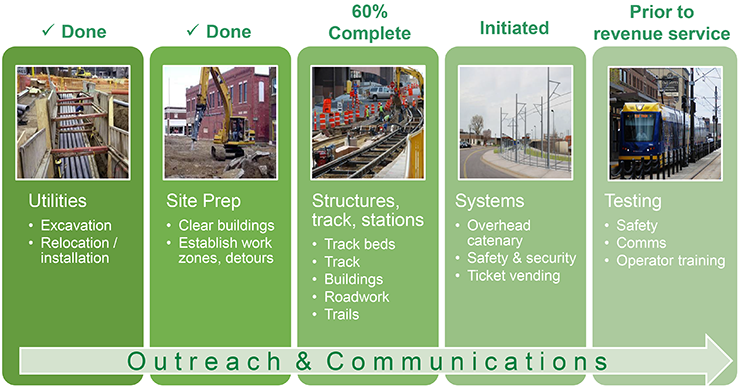Of all the questions Met Council Chair Charlie Zelle received during his second public grilling over the massive cost overruns on the Southwest Light Rail project, one was the hardest to answer. Call it the $500 million question.

“It will likely not come from any one place,” Zelle said. He cited the federal government, the council’s own funds and Hennepin County as sources of money to fill the budget hole. “We know it’s a gap that needs to be filled. And I have been assured by county commissioners and everyone I talk to that stopping the project would not benefit anybody.”
The Met Council announced in January that it had renegotiated contracts to add three years and $500 million to project schedule and budget, bringing it to what it termed “revenue service” in 2027. The new plan also includes both incentives and penalties for exceeding or beating the timeline.
“The most-important thing is that we have come forward with a plan that is not what people want to hear but it is what it is, which is there’s going to be a deficit, there’s going to be a schedule delay,” Zelle said in an interview last week.
Hennepin County ‘cannot cover additional cost increases alone’
The announcement only added to the criticism of the agency and gave opponents fresh ammunition for questioning the route of the line and its management.
While there was some early money from the state and from local governments along the now $2.7 billion line that will run from Target Field to Eden Prairie, the bulk of funding for the project has come from the Federal Transit Administration and Hennepin County. But once the federal government signed what is called a full funding grant agreement, it capped what it will contribute: $929 million — 50 percent of the project’s cost at the time but now just more than one-third of the project budget.
Hennepin County is the primary local funding partner and the Met Council as the manager of the project is obligated under the agreement with FTA, to complete and operate the project.

Though it covered a previous $200 million budget add-on, the county doesn’t have much left. And even if it could scrape up some more, political leaders there aren’t sure it is fair to keep tapping the county’s tax sources.
“Hennepin County has shown our commitment to the Green Line Extension, providing more than $1 billion to the project, making up nearly 90% of the local funding share,” board Chair Marion Greene said in a statement. “We cannot cover these additional cost increases alone. More importantly, it is not tenable for Hennepin County taxpayers to continue to be solely responsible for completing the largest infrastructure project in Minnesota history.
“It’s time for other partners to step forward with a comprehensive funding solution that acknowledges the statewide significance of this project,” Greene said. “We remain committed to working closely with partners at every level to complete this project and advance this long-term vision together.”
Because the project is 60 percent completed, the Met Council says there are few ways of saving money by scaling back the scope of the project as was done in 2015 to meet a previous budget overrun. If the project is abandoned, the council must not only repay federal funds but return the corridor to its pre-construction condition.
Zelle said last week the agency doesn’t need to identify the entire half-billion dollar gap at once but said some needs to be found this year to keep the project going. The Metropolitan Council starts work this week on the SWLRT funding issue. The council will consider a staff proposal to carve about $80 million from current council resources to keep the project on track for a 2027 opening. Part of that is an additional $30 million from Hennepin County that must be approved by the county board.
As with everything in the funding of these major projects, however, even that is complicated. Last year the federal American Rescue Plan included transit money with a specific carve out for light rail projects already under construction. The $30 million SWLRT received at first allowed Hennepin County to reduce its contribution by $30 million, which was the intention of the funds. But now the Met Council wants that money back.
Other changes will involve shifting some of the federal transit capital construction funds that regularly go to transit agencies the light rail project and then replace those funds with proceeds from a motor vehicle excise tax dedicated to transit, taxes that have been collecting more money than originally forecast. Moving that money around among Met Council funds would be temporary and be repaid once the agency gets its final allotments from the federal infrastructure bill adopted last fall. Minnesota will receive $818 million over five years to improve public transportation options across the state.
Metro Transit finance chief Ed Petrie called it “an orchestrated number of movements.”
Zelle called the moves a “a prudent use” of state and federal dollars at a time when the Met Council needs it.

But it will need more.
“We should show some leadership even though the Met Council — in the way these transit projects are funded — is not the source for local funds,” Zelle said. “We’re convinced this is the right thing to do.”
The Met Council is not allowed to permanently move state funds provided for regular and existing transit to cover expenses for the Southwest project. That is why the plan is to repay with federal infrastructure grants.
Still, Hennepin and Ramsey counties are the lead local funding partners thanks to their 50 cent sales tax, which replaced a quarter-cent sales tax used to fund projects under the now-defunct Counties Transit Improvement board, a five-county consortium that once helped fund regional rail and bus projects.
“We continue to have this conversation and are together in talking to our federal delegations and talking about federal sources,” Zelle said. “Nobody has put an ironclad no on the questions. If I were a county, I’d be saying the very same thing, that they’ve been burdened.
“The solution won’t be easy. Everyone is going to have to stretch,” he said.
An even more-troubled light rail line — Maryland’s purple line — recently was restarted with a $1.7 billion loan from the Build America Bureau through the federal Transportation Infrastructure Finance and Innovation Act.
“There are a number of different solutions around the county that you look to that goes beyond grant dollars,” Zelle said. “In my opinion we should be looking at all of these solutions. Nothing should be off the table.”
Hennepin County’s plan for spending its half-cent sales tax includes subsidizing operating costs on SWLRT beginning in 2022 for $28 million a year and the Bottineau extension starting in 2023 for $15 million a year. SWLRT won’t need that subsidy until 2027, according to the current schedule, and Bottineau has no completion date.
Zelle said he didn’t want to comment on how Hennepin County allocates local tax money but said he has sympathy for the county’s obligations to pay for construction and operations costs over time.
“This is a problem that can’t be solved by one entity,” Zelle said.
Skepticism at the Capitol
The Met Council is unlikely to receive more help from the state. Republicans in the Legislature have long been hostile toward the Met Council in general and light rail specifically. They have blocked state help in construction and have threatened to end a 50-50 sharing of light rail operating subsidies.
A move to direct the Office of the Legislative Auditor to investigate the project received broad support from both Republicans and DFLers in the Legislature.
Walz proposed $200 million for another light rail extension project, the Bottineau Line from Target Field to Brooklyn Park.
There is skepticism among Republicans as to whether that money would aid that still-being-planned extension or simply free up some of Hennepin County’s commitment to that line, which would allow money to flow back into SWLRT. At a contentious Senate Transportation Committee meeting last month, GOP senators questioned the Walz request.
“You’re asking for $200 million more for the next rail line when we haven’t even learned our lesson from this one,” said Sen. Dave Osmek, a Mound Republican who has been a longtime critic of the Met Council and light rail projects.
Zelle told the committee that the council has delivered two other rail projects — the Hiawatha line from downtown Minneapolis to the Mall of America and the Green Line from downtown Minneapolis and downtown St. Paul — on a reasonable timeline and budget. Neither, however, required the tunnels and blast walls that SWLRT has, Zelle said.
In response to a similar question during the House Transportation Committee from Rep. Jon Zoznick, a Lakeville Republican who called the project a boondoggle, Zelle gave a hopeful — or facetious — response.
“We are certainly open and interested in pursuing any proposals you have for state funding,” Zelle said. “That would be more than welcome.”


0 Commentaires